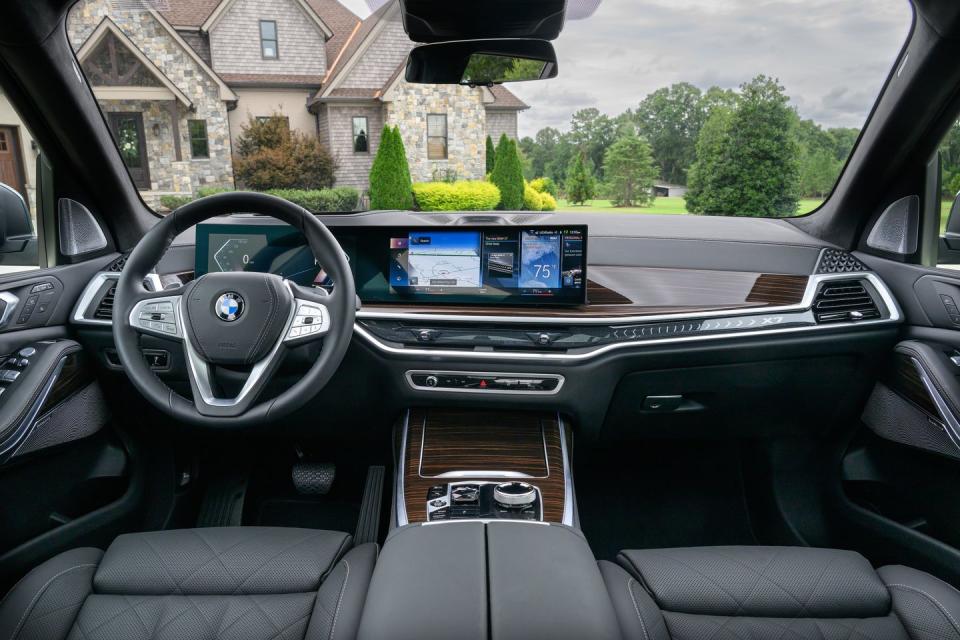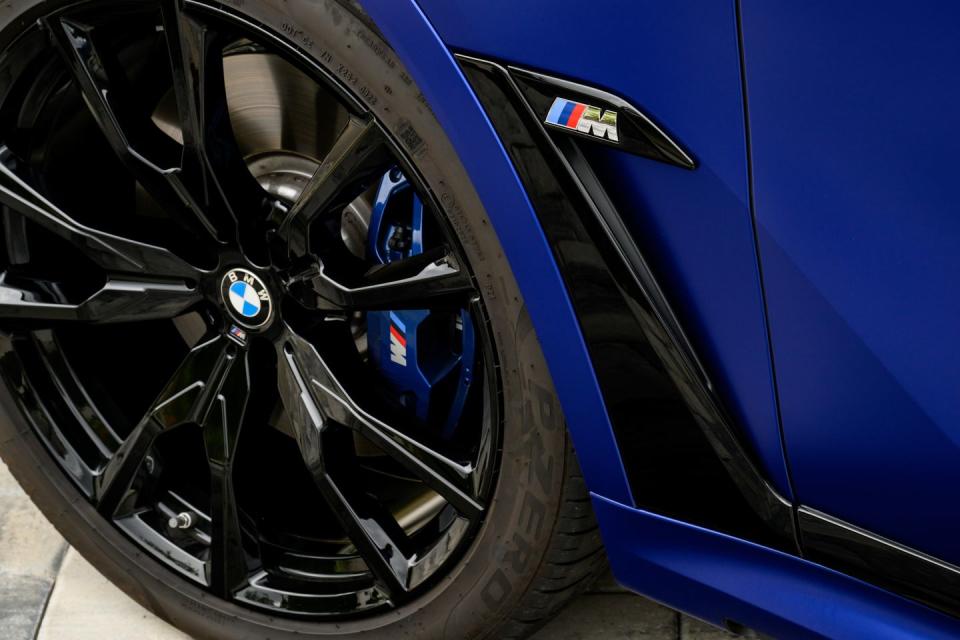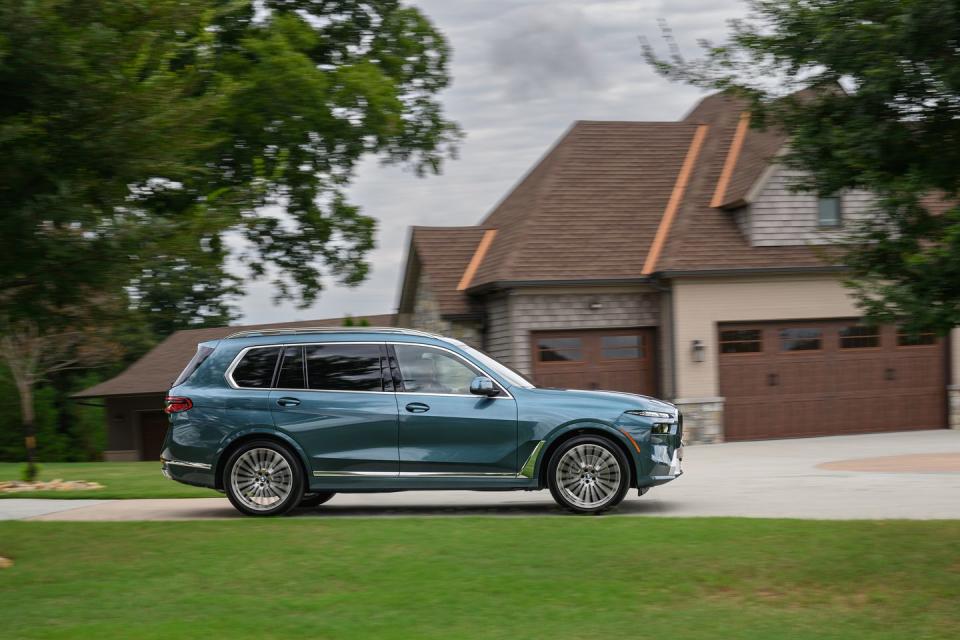The 2023 BMW X7 Has Been Refined, Not Perfected

The mid-cycle product refresh is an art. If the existing vehicle is selling well, why risk screwing up what’s working? If sales are soft, why waste time and money? A successful refresh is carefully calibrated, thoughtfully executed, and pays off in renewed excitement for a familiar machine. Superficial flourishes are rarely enough. Substance matters when re-framing a known product as “new.” The 2023 BMW X7 is… newish enough to attract some attention. At least good enough for satisfied lessees of the three-row X7 to lease this revamped one as a follow-up. But it hasn’t become a masterpiece.
What’s immediately apparent are the X7’s new Vader-spec nose, revised tail, and screen-heavy new interior. Improvements, but nothing unexpected.

The major substance for the updated X7 is in the drivetrain where all three revised engines are now married to a 48-volt mild hybrid system. To oversimplify (slightly), the hybrid system is essentially an electric motor sandwiched between the internal combustion engine and the familiar ZF 8HP eight-speed automatic transmission’s torque converter. The zap motor only adds 12 horsepower to the party, but it smooths out torque delivery. Not that torque production was previously inconsistent.
Putting aside the 352-horsepower, 3.0-liter diesel six which won’t be sold in North America, the X7 line consists of two models. The 380-hp, xDrive 40i is the six and the 530-hp M60i xDrive is the V-8. There will also be a more potent, 630-hp tune of the same V-8 available in the 2023 Alpina XB7, but that car isn't available to drive yet. All models are assembled in BMW’s massive plant in Greer, South Carolina which is the source of X3, X4, X5, X6, and X7 sport-ute models for the whole dang world. As it is atop that pyramid, the X7 is likely the most expensive consumer product built in the state. That puts it up as the second most expensive vehicle built there behind Boeing’s 787.

The xDrive 40i (BMW, please, stop with the xDrive) is powered by the latest evolution of BMW’s twin-turbocharged 3.0-liter which now runs on the Miller-cycle principle with laggard intake valves that reduce resistance during the compression cycle. The cylinder head is new with a fresh combustion chamber design and all-electronic operation of the VANOS variable valve-timing and lift. In the original 2018 X7, this engine’s predecessor was rated at 335 horsepower and, even when the hybrid system isn’t making a contribution, this one goes off at 380. So, good.
Likewise, the M60i xDrive’s V8 has been similarly tweaked. It still displaces a nominal 4.4-liters but the turbos, nestled in between the cylinder banks, are now symmetrically plumbed to perform identically. Like the six, it produces maximum power even when the hybrid system isn’t contributing. While the 530-horsepower rating is impressive, even more so is the 553 pound-feet of consistent torque produced between 1800 and 4600 rpm. No wonder BMW is also promoting the X7’s 3500-pound towing ability.

As to the aesthetics, the nose is busier than before and continues BMW’s current trend of enormous nostrils. The headlights have been horizontally split and that extends the “face” to the far edges better than before. But it’s still a riot of shapes that don’t quite cohere to a single theme. More successful are the revisions to the tail where new lighting and trim reduce the massive appearance and knock down some of the awkwardness that has plagued the X7 since its 2018 debut.
But while the exterior has been tweaked, the interior has been dragged into the 21st century with a comprehensive updating. The most obvious element is a new curved digital dashboard that is bifurcated into a 12.3-inch plot of pixelated real estate dedicated to traditional automotive information and a 14.9-inch display on the same plane. That screen is used for everything from radio station choice to rearview camera displays and even for directing the X7 using the iDrive control knob while backing up with a trailer.

Technology can be helpful, but the revised X7 has so much tech aboard it may irradiate potatoes and melt butter. Now, driven by the new BMW Operating System 8, the X7 only trusts the driver so much. It monitors the driver’s attention, can center itself in a lane, park itself, and back itself out of a spot by retracing the driver's inputs that got it there.
Some of these tech elements are valuable, even if they have a deep learning curve. For instance, the new trailer assistance system first learns the trailer’s dimensions and then guides the trailer at low speeds while backing while using the iDrive knob. It’s a great way to inspire confidence if backing trailers is a regular thing. But it may not be something the typical X7 lessee learns before it’s time to turn it back into the dealership. To learn everything the X7 tech pod can do takes a commitment that may be beyond the recently retired CEO who wants to use this big crossover to bounce between his or her new 14,000-square-foot home in Montecito and the shops along Rodeo Drive.

Slightly distressing was BMW’s explanation of the small lever shifter now mounted in the center console. This tiny switch may save on console real estate and is at least as effective as the wacky wand that has controlled BMW automatic trannies for the past few years, but it’s hardly engaging. And BMW explained its advantages as freeing up space for cupholders and phone chargers. This is from B-M-W which still makes a few outstanding manual transmissions guided by outstanding shifters. What is it doing talking up drink holders and cell phone chargers? For Bavaria’s sake, don’t do this. At least make an argument that emphasizes driving. There ought to be polemicists parachuting into Munich now to come up with some plausible alternative explanations.
Both engines start off the 48-volt system instead of the (now a backup) 12-volt starter. The six is a creamy, high butterfat treat. There’s not much of a sing-song note (BMW made a choice to not include any 40i models equipped with the performance exhaust on our drive), but when it is heard, it’s dang perfect. Mellow, engaging, and resonant of BMW sixes stretching back to World War I, it’s a melody that made BMW beloved. And there it is, backed by about the most powerful six BMW has put into a vehicle that doesn’t wear an M badge.
On the road, the 40i is nimble despite its size and rides like it’s on a cloud of frothy asphalt. With rear steering effectively shrinking down the 122.25-inch wheelbase to, say, 105-or-so inches, this is among the most easily positioned big SUVs available. In Chevrolet terms, it’s the size of Tahoe but drives smaller than an Equinox. There is one caveat.

For the love of all things good and mechanical, do not buy the 23-inch wheels. Do. Not. Buy. The. 23s.
From a business standpoint, it makes sense for BMW to now offer 23-inch wheels on the X7. After all, there are plenty of buyers out there who will reflexively add the biggest diameter wheels possible to an X7 before they even get it home. And many of these heavy and dopey wheels will be wrapped in absurd tires. So why shouldn’t BMW capture some of those lunatic buyers’ money before it escapes to the rest of the world? But the 23s simply don’t leave enough sidewall to avoid massive sonic slams whenever a pothole is encountered. The airbags in the suspension don’t allow much of that wallop to transfer into the structure, but the sound is as if the X7 has been head-butted by a bulldozer. Meanwhile, the X7 works great on the also-huge 21-inch wheels and 285/45R21 tires fitted as standard.
Don’t buy the 23s. Please.

While BMW has the 40i waltzing to 100 kph (62 mph) in 5.8-seconds, the M60i hits the same mark in a thumping 4.7-seconds. The best part of the M60i is that it doesn’t demand much of a compromise in comfort or quiet for that additional rocketry. And the big V8 makes a great sound (if not so lilting) of its own. The 40i is more than adequate, while the M60i spits on adequacy and crushes it under its imperious blacked-out trim.
Prices for the standard X7 range will run from expensive ($78,845 for a base 40i) to around $120,000 for a huffed up M60i that includes $5000 worth of “Frozen Grey Metallic” paint, the Executive Package, Climate Comfort Package, Driving Assistance Professional Package, M Sport Professional Package, leather dash cover, second-row captain’s chair, the Bowers & Wilkins audio system, and a $995 destination charge. And the range-topping Alpina XB7 will be even spendier when it arrives.
Such is the price of art.
You Might Also Like

 Yahoo Autos
Yahoo Autos 